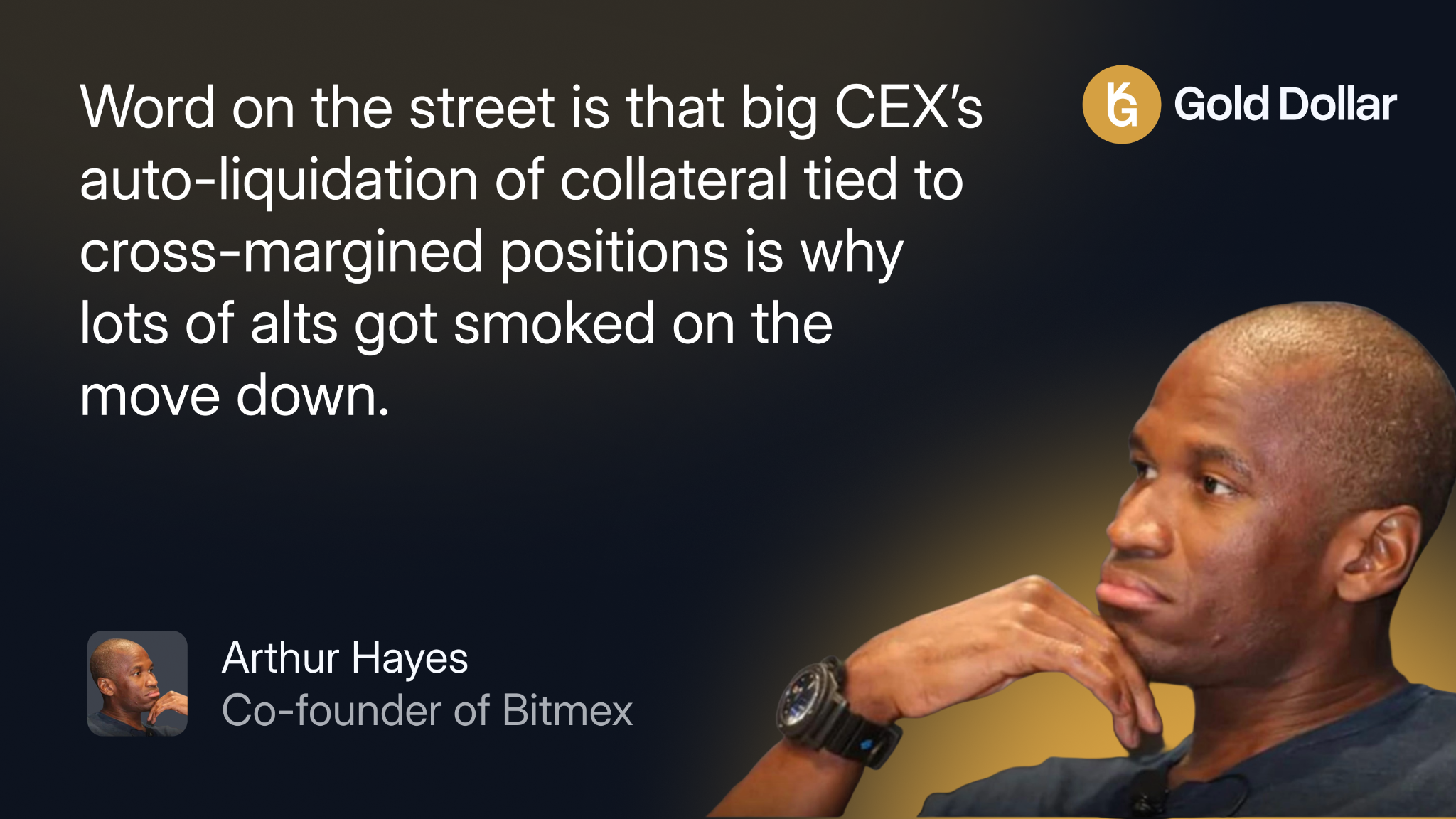The $19B Lesson: Why Gold-Backed Stablecoins Prove More Resilient in Market Crashes
October 14, 2025

The latest drawdown was swift and indiscriminate. In the span of hours, cascading liquidations erased roughly $19 billion of notional value across crypto derivatives, forcing asset sales into already thin order books and accelerating price declines. By the next trading session, the familiar triage had begun: stability seekers rotated into cash equivalents on-chain, market makers rebuilt inventory, and exchanges widened spreads until volatility normalized. In that churn, one pattern stood out. Gold-backed tokens—notably PAXG and XAUT—held their peg and in some venues even gained modestly, tracking the contemporaneous outperformance of bullion while beta assets whipsawed lower.
The price action was not purely cosmetic. It spoke to a deeper divide in how different “stable value” instruments behave under stress. Fiat-redeemable stablecoins did what they were designed to do—serve as dollar liquidity for “buy the dip” flows—while gold-linked tokens behaved like claims on an alternative, non-bank reserve asset, preserving value as risk was repriced. Together, they formed the market’s safety ladder: dollars for liquidity, gold for durability.
This article examines the mechanics behind that divergence and what it implies for the next cycle. It argues that stable value is not monolithic; the reserve asset matters. In a regime defined by rate volatility, periodic funding squeezes, and policy uncertainty, instruments that combine on-chain finality with off-chain resilience will prove most useful to institutions and protocols alike. The evidence from last week’s rout points to an expanding role for gold-backed stability—and clarifies where a model like USDKG fits.
Liquidity vs. Durability: What the Crypto Market Crash Made Obvious
Stress reveals function. The forced unwind was triggered by a familiar chain: sharp spot moves, derivatives liquidations, and a scramble to source margin. As venues liquidated positions, fiat-redeemable stablecoins were minted at scale—notably by Tether and Circle—in response to elevated demand for dollar collateral and settlement balances. Minting spigots are the shortest route to triage: they restore buying power, let market makers reset, and keep exchanges clearing. In short, they are emergency liquidity valves for crypto markets.
Gold-backed tokens play a different role. Because they are claims on bullion rather than deposits or short-dated bills, their value depends on the gold risk factor, not banking system conditions. When a macro shock or a market-microstructure shock triggers deleveraging, bullion’s historical defensiveness often asserts itself. In this episode, PAXG and XAUT remained firm even as high-beta assets fell, with some venues showing modest premiums as investors sought refuge in metal-linked exposure that still settles on chain.
Two complementary conclusions follow. First, dollar stablecoins are the market’s pipes—programmable money for 24/7 liquidity. Second, gold-backed tokens are the ballast—programmable claims on a non-bank reserve that tends to hold value when risk parity breaks down. The crash

compressed these functions into a single trading day.
The Reserve Question: What Stablecoin Reserves Really Hold and Why It Matters
Stable value is never abstract. It is backed by something. During normal conditions, the distinction between a token redeemable for bank money and a token redeemable for bullion can appear academic; under stress, it is decisive.
Fiat-redeemable stablecoins are typically backed by cash, bank deposits, and very short-duration Treasuries. In ordinary markets, that portfolio delivers tight spreads, rapid redemptions, and robust liquidity—an ideal configuration for market makers. But the structure is, by design, tied to the health of the banking system and the Treasury bill complex. Market participants learned in 2023 that bank-specific shocks (e.g., a regional bank failure) can momentarily complicate redemptions or create price dislocations, even when they are quickly resolved.
Gold-backed tokens invert that dependency. Their value rests on allocated bullion held in custody, with issuance and redemption reflecting metal inflows/outflows rather than bank balance-sheet capacity. When a risk event reprices growth or policy, bullion’s role as a non-liability reserve asset can provide stability that fiat-linked constructs—however well managed—cannot replicate. Coverage across the weekend rout highlighted exactly that behavior: gold-linked instruments held firm while crypto beta reset, consistent with bullion’s relative strength year-to-date.
This is not an indictment of dollar stablecoins; it is a reminder about portfolio construction on chain. Different liabilities cushion different shocks. A venue, protocol, or treasurer seeking to minimize gap risk may choose to hold both—dollars for operating liquidity; gold for balance-sheet resilience.
Volatility Regimes and the Case for Dual Collateral: Fiat vs. Gold-Backed Stablecoins in Crypto Markets
The current cycle is characterized by rate volatility, intermittent funding stress, and macro headline risk that can reprice term premia quickly. In such a regime, instruments that are liquidly redeemable and programmatically composable yet differentiated in their reserve drivers should gain share.
After the crash, stablecoin issuance increased as market participants rebuilt settlement balances and positioned for dislocations—a pattern noted repeatedly in prior drawdowns. At the same time, gold-linked tokens preserved value, serving as a risk-off anchor inside the same on-chain rails. The combination is pragmatic: operate in dollars, insure with metal—both tokenized, both T+0, both native to DeFi.
Institutional desks, exchanges, and protocol treasuries can codify this logic. Collateral baskets that include a gold-backed component alongside fiat-redeemables can reduce the probability that all “stable” exposure is sensitive to the same off-chain trigger. The aim is not to time gold; it is to diversify reserve dependencies without forfeiting on-chain finality.
Microstructure Lessons from the Stablecoin Market: What Survives the Next Liquidation Wave
Three operational takeaways emerged from the episode. As former BitMEX CEO Arthur Hayes observed after last week’s cascade, “Word on the street is that big CEX’s auto-liquidation of collateral tied to cross-margined positions is why lots of alts got smoked on the move down.”
His remark captures the structural vulnerability exposed by the $19 billion liquidation event—where automated leverage loops, not fundamentals, drove prices lower. The episode underscores why assets anchored in tangible collateral, rather than margin systems, maintain their integrity when liquidity evaporates.

First, depth migrates to instruments that clear everywhere. Dollar stablecoins remain the dominant quote leg and settlement asset across centralized exchanges and DeFi pools. Their connectivity—issuers, market makers, custodians, and venues—makes them irreplaceable for intraday risk transfers. That role persisted through the drawdown.
Second, risk-off demand for tokenized gold is not anecdotal. Order-book behavior during the rout showed sticky bids for metal-linked tokens even as top-line crypto indices sold off. For participants who cannot—or will not—leave on-chain rails for off-chain gold exposure during stress, tokenized bullion is now a demonstrated alternative.
Third, the “mint on shock” reflex is now part of market hygiene. In the hours after liquidations peak, issuers with robust treasury operations expand supply to meet demand for cash-equivalents. That elasticity is not a flaw; it is a stabilizer. The caveat is well known: those reserves are bank- and bill-dependent. Complementing them with non-bank reserves is the logical evolution for on-chain risk frameworks.
Policy Context: G7 Currencies, Types of Stablecoins, and the Ongoing Debate Over What Backs Them
Each crash restarts the same policy conversation. Regulators focus on run dynamics, reserve transparency, and the potential for stress transmission between token markets and the traditional system. Market coverage over the weekend underscored these themes yet again: fiat-redeemables excel at elasticity but remain exposed to banking-system contingencies; gold-backed tokens do not share that exposure, though they inherit the risk characteristics of bullion.
From a prudential standpoint, the question is not whether one model is categorically “better.” It is whether critical on-chain functions—treasury, collateral management, protocol backstops—are built on single-factor reserves. For venues and protocols with public risk disclosures, a diversified reserve approach is increasingly defensible: publish the mix, explain the rationale, and align it with stress-test scenarios that are specific to crypto microstructure.
What the Stablecoin Market Evolution Means for Institutional Investors
Institutions evaluating on-chain working capital and collateral have practical constraints. They need T+0 settlement, broad exchange connectivity, verifiable reserves, and auditable processes. They also need to segment operational liquidity from capital preservation.
The weekend’s tape offers a straightforward allocation framework:
- Use fiat-redeemable stablecoins for operating liquidity—market making, settlement balances, and intraday funding—because nothing else clears as broadly or as fast.
- Hold a gold-backed sleeve for balance-sheet resilience—not as a directional trade, but as a non-bank claim that historically tracks a different risk factor and proved durable in the latest shock.
This is not theory. It is the architecture that market behavior just revealed in real time.
Where USDKG Fits in the Stablecoin Market: Gold-Backed Credibility and On-Chain Payments Infrastructure
USDKG is built for this duality. It is gold-backed—fully collateralized by physical bullion held in custody with independent verification—and on-chain native, intended to interoperate with DeFi venues and settlement flows that require 24/7 finality. In other words, it aims to deliver metal’s durability without leaving the programmable rails that institutions now require.
The model addresses three pain points highlighted by the crash:
Reserve dependency. Fiat-redeemables are excellent dollar pipes—but they depend on banking-system solvency and bill market liquidity. A gold-backed instrument complements that exposure with a non-bank reserve base that behaved defensively in the latest drawdown. The weekend tape is a live case study.
Transparency and auditability. Post-crisis adoption depends on verifiable proof of backing. USDKG’s commitment to independent verification aligns with the disclosure standards institutions expect when they add a new reserve instrument to treasury policies.
Programmability at parity. A tokenized claim on gold is only useful if it remains composable—available as collateral in lending markets, usable in automated strategies, and fungible across custody stacks. USDKG’s roadmap prioritizes DeFi integrations so that gold-backed stability does not require operational trade-offs.
Put simply: keep dollars for pipes; use gold for ballast—both tokenized, both auditable. USDKG is engineered to fill the latter slot.
Risk Considerations: Lessons from Algorithmic Stablecoins and Asset-Backed Alternatives
No reserve model is riskless. Fiat-redeemables carry banking and bill market risk; gold-backed tokens inherit metal price risk and custody dependencies. A prudent on-chain treasury policy articulates when and how each sleeve is used, how redemptions are handled under stress, and how collateral haircuts are set in lending markets.
The goal is not to anoint a single instrument as universally superior. It is to match reserve types to functions and to avoid concentration in a single off-chain dependency. The crash has made that case more, not less, compelling.
Designing for the Market We Have
After last week’s liquidations, the market signaled its preferences decisively. Dollar stablecoins remain the liquidity standard, elastic enough to absorb shocks and broad enough to clear across venues. Gold-backed tokens are the durability standard, offering a credible non-bank counterweight that preserved value as leverage unwound. The most resilient on-chain architectures will use both.
For institutions, exchanges, and protocols building for the next cycle, the design brief is clear. Keep operational cash in instruments that clear everywhere, and hold stability sleeves in instruments that are resilient to the very shocks that force you to use them. In that framework, USDKG is not a slogan; it is a specific response to a specific need that the market has just re-demonstrated under real stress.
.svg)


